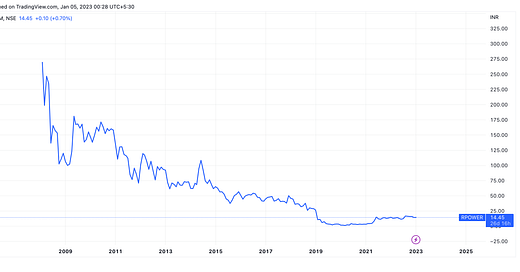Welcome to my blog! I began my investing journey during the 2003-2008 bull market, and my first investment was in the Reliance Power IPO.
At the time, it was the largest IPO in India and I was fortunate (or so I thought) to be allotted shares at an offer price of 450 INR. However, fast forward to 2022 and the stock price has fallen to 14.5 INR per share – a decline of 97%.

Unfortunately, this was not my last investing mistake, but the last 15 years of my journey have been a valuable learning experience.
Through trial and error, I've learned developed a framework to help me navigate the complex world of investing.
Join me on my journey as I share my experiences and insights with you.
Investing comprises of 4 important steps
Investing can seem like a daunting task, with so many options and strategies to choose from. That's why it's important to break the process down into smaller, more manageable steps.
In this series of four blogs, we'll explore my investment framework, which consists of four key steps:
Stock selection (What to buy?),
Position sizing (How much to buy?),
Entry ( When to buy?)
Exit (When to sell?)

Known-Unknown framework for stock selection
In this first blog, we'll focus on stock selection, or deciding what to buy.
There are many approaches to investing, including index investing, trading, value investing, mutual funds, and growth investing. The goal is to find the right investments for your portfolio.
To make things simpler, let's consider the NSE 500 index, which includes the 500 best companies listed in India. Using a framework called the "known-unknown" framework, we can navigate the complex world of investing. This framework consists of four categories:
Known knowns: These are opportunities where both you and the market know that a particular investment is a good buy. These are often consensus buys, like blue-chip stocks or index funds/ETFs.
Who are suitable for this style ? -
These types of investments are generally considered to be lower risk and hence risk averse investors may choose this ;
Investors who are just starting out and want a more stable and predictable investment strategy.
Unknown knowns: These are opportunities where you know about an opportunity, but the market doesn't. To identify these opportunities, it's important to develop a "zone of competency," or a deep understanding of an industry or company. This is the strength of mutual fund managers or PMS advisors, who do thorough research and pick the right stocks to invest in. If you don't feel confident in your ability to develop a zone of competency, consider investing in a good mutual fund.
Who are suitable for this style ? -
Investors who are interested in actively researching and analyzing specific industries or companies, and who have a high level of confidence in their ability to identify promising investment opportunities ;
Investors who have a high risk tolerance and are willing to take on a more active role in managing their investments.
It's important to keep in mind that this approach requires a significant time commitment and a high level of knowledge and expertise. It may not be suitable for all investors.
Known unknowns: These are opportunities where the market knows about an opportunity, but you don't. Big institutional investors like mutual funds and pension houses are often the first to identify a potential stock, and they leave their mark on the market with large volumes of trades. By using technical analysis to identify these trends, you can pick promising stocks without necessarily needing a deep understanding of the company or industry. This approach is preferred by traders who are more interested in chart setups than specific stocks. We'll delve more into technical analysis in later blogs, which is my preferred style of investing.
Who are suitable for this style ? -
Traders who are interested in using technical analysis to identify potential investment opportunities ;
Investors who are comfortable with a higher level of risk and are willing to actively manage their investments by closely following market trends and making frequent trades.
Unknown unknowns: These are opportunities that neither you nor the market knows about. Angel investors and venture capital investors often fall into this category, as they take a "spray and pray" approach and hope that some of their ventures will be wildly successful.
Who are suitable for this style ? -
Investors who are interested in taking a more speculative and high-risk approach to investing, and who are willing to invest in a wide range of startups and early-stage companies with the potential for high returns, may be the right target audience for "unknown unknown" investing.
This approach is typically only suitable for investors who have a very high risk tolerance and are willing to accept the possibility of losing their entire investment.
It's important to keep in mind that this style of investing carries a high level of risk, and it may not be suitable for most of the retail investors.

It's important to identify which style of investing aligns with your goals and risk tolerance, and to stick with it. By breaking down the process into these four steps and following a disciplined approach, you can make informed decisions and potentially achieve your investment objectives.
As former US Secretary of Defence Donald Rumsfeld famously said,
"there are known knowns; there are things we know we know. We also know there are known unknowns; that is to say we know there are some things we do not know. But there are also unknown unknowns – the ones we don’t know we don’t know."



